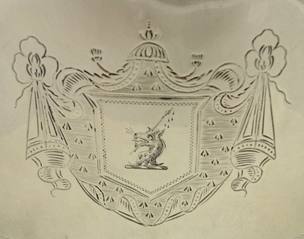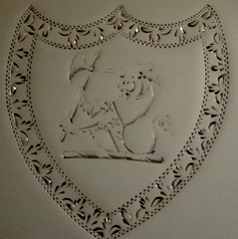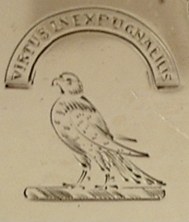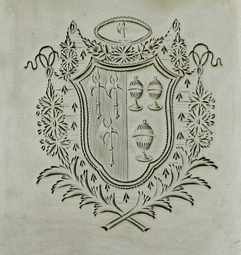by Joanne and Emmett Eldred
(click on photos to enlarge image)
COLLECTING SILVER TEAPOTS AND STANDS
OUR COLLECTING GUIDELINES (6)
The following is the sixth in a series of papers, which
discuss several of the criteria we use in evaluating pieces we
collect. These discussions will highlight our approach when
considering form, originality of teapot and stand combinations,
engraving, hallmarks, condition, and crests & coats-of-arms. In
most cases we have used pictures from our modest but growing
collection to illustrate what is being described.
As is the case with collecting almost anything, the initial
learning curve can be quite steep. Being fairly new to the
subject it certainly applied to us. Our initial screen involved
only two basic areas; form and hallmarks. Our assessment of form
was subjective and based solely on our personal tastes at the
time. Of course having seen only a few examples we did not have
a broad reference base and therefore were unaware of the variety
of designs produced during the later part of the 18th century.
Our second screen was centered on hallmarks. As noted earlier,
one advantage in collecting English silver is its hallmarking
system. Fortunately we were able to locate several excellent
Websites for researching hallmarks, especially maker's marks.
Looking back on things we were very lucky with the majority of
our early purchases. We could have made some costly mistakes
because we did not realize that several other key factors, such
as crispness of the engraving, absence of repairs, surface
patina, presence of an identifiable coat-of-arms or crest, etc.,
significantly contributed to the desirability and therefore the
value of a set.
Over time we became more knowledgeable and ultimately developed
a pretty rigorous set of criteria for evaluating pieces we were
interested in purchasing. Our approach currently involves a
number of assessments (form, originality, engraving, hallmarks,
condition, crest), which we will describe over a series of
articles.
Part 6: CREST OR COAT-OF-ARMS
As mentioned earlier we tend to
purchase sets with a family crest and/or coat-of-arms. We have
found that researching an engraving on a piece to try and
determine its possible family connection adds considerably to
our collecting enjoyment.
The process of researching a crest or coat-of-arms involves
number of interesting activities and one quickly fashions
himself as a detective trying to solve a mystery. The first step
is sorting through the various heraldic terms and meanings. This
is not an easy task when one considers that individuals in the
19th century spent their entire careers focused on the subject
and a few were even knighted for their heraldic proficiency and
contributions (e.g., Bernard Burke in 1855). However
understanding heraldic terminology is necessary to translate the
pictorial version of a family’s crest or coat-of-arms (emblazon)
into words, or heraldic blazon.
Armed with a description in heraldic blazon, one begins wading
through numerous reference books to try to match the blazon to a
family. In the case of a crest this can be very difficult since
several families often used the same crest; however a
coat-of-arms, in most cases, was unique for a given family or
branch. Unfortunately, this process is not as straightforward as
one might imagine. Over time, many heraldic records have been
“lost” (probably residing somewhere but not cataloged and/or
accessible) or were not picked up by the people creating the
majority of the reference books (typically these books were
written during the later part of the 19th and early part of the
20th centuries).
However, sometimes one gets lucky. For example we purchased two
pieces with crests, one of the Mynors-Baskerville family (wolf
holding a broken spear in its mouth with drops of blood falling
from the spear tip) and the other of the Calley family (lion’s
upper body holding a battle axe in its right paw with a banner
draped across its chest with three stars.) In both instances the
crests were pretty much unique to the individual families and
therefore identification was fairly straightforward.
 |
 |
Mynors-Baskerville family crest
|
Calley family crest
|
On the other hand, we own several
other examples where the research is still ongoing. For instance
the following crest of a falcon or hawk can be associated with
more than eighty-six families.

Falcon or hawk with VIRTUS INEXPUGNABILIS motto
|
By itself, it would be
almost impossible to link the crest to a specific
family. However in this instance there is also a
family motto, VIRTUS INEXPUGNABILLIS ("unconquerable
virtue"), which should make the task much easier.
Unfortunately we have not been able to find any
examples of VIRTUS INEXPUGNABILIS being used as a
family motto, much less used in conjunction with a
falcon or hawk crest.
As a side note: looking carefully at the picture --
the engraver misspelled INEXPUGNABILIS on both the
teapot and stand. In each case he spelled it "INEXPUGNAEILIS".
Likely he was given handwritten instructions or a
poorly printed reference document and mistook the
"B" for an "E".
Fortunately for the engraver, the lettering is small
enough that we seriously doubt the purchaser ever
noticed it.
|
For those cases where a definitive
family has been identified, it is then fun to see if it is
possible to identify who might have purchased or owned the set
by checking town records for marriages or inheritances that
might have occurred around the time of the piece's manufacture.
However, many documented historical accounts indicate that
silver was often purchased years after a marriage or inheritance.
Therefore, this research usually results in conjecture (or
wishful thinking) at best -- but it does add an element of
ongoing adventure to the pieces.
For example, in the case
of our first purchase the armorial engraving likely
depicts the Ainsworth family impaling another family
(possibly the Nowell or Pulverston family).
The coat-of-arms of the male is depicted on the "dexter",
or right side (looking out from behind the shield),
while the female's coat-of-arms is on the "sinister",
or left side.
The charge of the impaling family is depicted above
the shield, and in this case, it is the Ainsworth
family.
This impaling most likely represented a wedding, but
in our research of town records from 1780 through
1800 we have not been able to find any marriages (or
other associations) between an Ainsworth and either
of two families noted earlier.
|

Likely the Ainsworths impaling another, as yet
unidentified, family
|
We will continue investigating other
possible family combinations but there is a distinct possibility
we will never arrive at an acceptable theory. However as they
say, “chase is half the fun”, and for us the exploration with
the hope of a discovery is an important part of our overall
collecting experience.
Joanne and Emmett Eldred
- 2012 -
|
|
|

